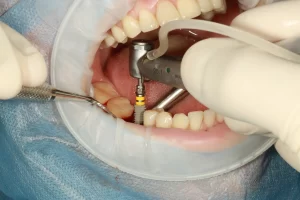Dental crowns are an essential part of restorative dentistry, helping to restore damaged or weakened teeth to their former strength and appearance. However, like any dental prosthesis, crowns are not immune to wear and tear or damage. When a dental crown becomes damaged, the natural question arises: can it be repaired, or is replacement the only option?
In this comprehensive guide, we will explore the world of dental crowns, their vulnerabilities, and whether can a dental crown be repaired. By the end of this article, you’ll have a clear understanding of when a dental crown can be repaired, what the repair process entails, and how to ensure the continued health and longevity of your dental crown.
Understanding Dental Crowns
Dental crowns, often referred to as “caps,” are custom-made tooth-shaped covers that fit over a damaged or decayed tooth. They serve several essential functions, such as protecting weak teeth, restoring the shape and function of damaged teeth, and improving aesthetics. Crowns can be made from various materials, including ceramic, metal, and porcelain-fused-to-metal, each with its own set of advantages and disadvantages. While dental crowns are designed to be durable, they are not invincible.
Common Reasons for Dental Crown Damage
Dental crown damage can occur for a variety of reasons, and it’s essential to be aware of these factors to understand whether repair is a viable option. Some common causes of dental crown damage include:
- Decay or Cavity Formation: Over time, decay can develop underneath the crown, compromising the tooth’s structure and the crown’s stability.
- Wear and Tear: Daily activities like chewing and grinding can gradually wear down a crown’s surface, leading to damage.
- Accidental Damage: Trauma from accidents or injuries can chip, crack, or dislodge a dental crown.
- Poor Oral Hygiene: Neglecting proper oral hygiene can result in gum disease and other issues that affect the integrity of dental crowns.
Assessment of Damaged Dental Crowns
To determine whether a dental crown can be repaired, it’s crucial to undergo regular dental check-ups. Dentists use X-rays and visual examinations to assess the condition of both the crown and the tooth beneath it. Signs and symptoms that may indicate a damaged dental crown include sensitivity, pain, visible cracks, or changes in the crown’s appearance.
Repairing Dental Crowns
Repairing a dental crown is possible in many cases, depending on the extent and nature of the damage. Common methods for repairing dental crowns include:
- Crown Re-cementation: If the crown has become loose but is undamaged, it can often be re-cemented securely onto the tooth.
- Filling Cavities: If decay has formed beneath the crown, the dentist may remove the crown, address the cavity, and then restore the crown to its original position.
- Crown Reshaping and Polishing: Minor chips or rough edges can be smoothed out through reshaping and polishing.
However, the decision to repair a crown isn’t always straightforward.
Crown Replacement vs. Repair
Whether to repair or replace a damaged dental crown depends on several factors, including the extent of the damage and the crown’s age. Here are some considerations:
- Extent of Damage: Extensive damage or structural issues may necessitate crown replacement for long-term stability.
- Age of the Crown: Older crowns nearing the end of their lifespan may benefit more from replacement.
- Material and Aesthetic Concerns: In some cases, repairing a crown may affect its appearance or result in less favorable outcomes than a replacement.
The choice between repair and replacement is ultimately made by the dentist, considering these factors and the patient’s best interests.
The Repair Process
For those fortunate enough to have a dental crown that can be repaired, understanding the repair process is essential. Here’s a step-by-step breakdown:
- Removal of the Damaged Crown: The dentist carefully removes the damaged crown to assess the condition of the tooth underneath.
- Assessment of the Tooth’s Condition: If there is decay or other issues, the dentist addresses them before proceeding.
- Restoration of the Crown: The damaged crown is repaired, reshaped, or reinforced as needed.
- Re-cementation and Final Adjustments: Once the crown is in optimal condition, it is securely re-cemented onto the tooth, and final adjustments are made for a proper fit.
Throughout the process, patients are often concerned about pain or discomfort. Dentists prioritize patient comfort and use local anesthesia as needed to ensure a painless experience.
Costs and Insurance Coverage
The cost of repairing a dental crown versus replacing it can vary significantly. Repairing a crown is generally more cost-effective, but the final expense depends on the specific procedure needed and the dental professional’s fees. Dental insurance may cover part or all of the costs, so it’s advisable to check with your insurance provider regarding coverage.
Additionally, if the cost is a concern, many dental offices offer financing options or payment plans to help patients manage the expenses associated with crown repair. If you want to learn more about how much are dental crowns, check out our blog page today!
Maintaining Crown Health
Whether you’ve had your dental crown repaired or replaced, maintaining its health is crucial for long-term success. Here are some essential tips:
- Maintain Excellent Oral Hygiene: Brush and floss regularly to prevent decay and gum disease.
- Avoid Hard Foods: Be cautious with hard or sticky foods that can damage crowns.
- Regular Dental Check-ups: Visit your dentist for routine check-ups and cleanings to detect and address any issues early.
Conclusion
In conclusion, the repair of a dental crown is indeed possible in many cases, offering a cost-effective and practical solution to damaged or compromised crowns. However, whether a crown can be repaired or requires replacement depends on several factors, including the extent of the damage and the crown’s age. It’s crucial to consult with your dentist, who can provide a personalized assessment and recommend the best course of action.
Remember, maintaining good oral hygiene and seeking regular dental check-ups are essential for the health and longevity of your dental crown. By staying proactive and informed, you can ensure that your smile remains bright and functional for years to come. If you suspect an issue with your dental crown, don’t hesitate to schedule a consultation with your dentist and explore the possibility of repair. Your smile’s health and appearance are worth it.
Experience Expert Crown Repair
Don’t let a broken dental crown ruin your smile. At Belle Smile Dentistry, we have the expertise to repair your crown and make it as good as new. Our skilled dental crowns St. Catharines dentists use the latest techniques and materials to ensure a seamless repair process. Say goodbye to discomfort and inconvenience. Take action today – book an appointment with Belle Smile for reliable crown repair services!
FAQs: Can a Dental Crown be Repaired?
What types of damage can be repaired on a dental crown?
Dental crowns can often be repaired if they have minor chips, cracks, or wear. However, extensive damage or a completely broken crown may require replacement. The decision will depend on the crown’s condition and your dentist’s evaluation.
How is a dental crown repair performed?
Dental crown repair typically involves removing any damaged portions of the crown and then reshaping and bonding new material to restore its structure and aesthetics. The procedure is performed by a skilled dentist who ensures a secure and comfortable fit.
Are there limitations to repairing dental crowns?
While many damaged crowns can be repaired, there are limitations. If the crown is severely fractured or if the underlying tooth structure is compromised, repair may not be possible, and replacement may be necessary. Your dentist will evaluate the specific circumstances to provide the best recommendation.
How can I determine if my dental crown needs repair or replacement?
If you suspect your dental crown is damaged or experiencing issues, it’s essential to schedule an appointment with your dentist promptly. They will conduct a thorough examination, including X-rays if needed, to assess the crown’s condition. Based on their evaluation, they will advise you on whether repair or replacement is the best course of action to ensure your oral health and smile aesthetics are maintained.



